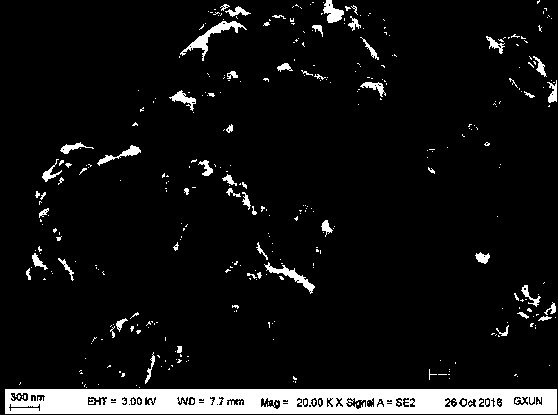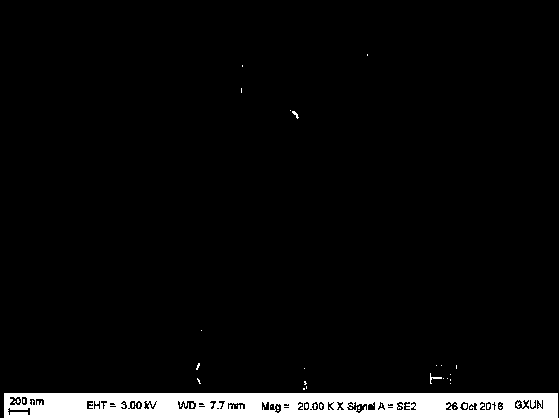Preparation method of porous g-C3N4 with high specific surface area
A high specific surface area, g-c3n4 technology, used in chemical instruments and methods, catalyst activation/preparation, physical/chemical process catalysts, etc. Product cost, high application prospect and practical value, the effect of simple process
- Summary
- Abstract
- Description
- Claims
- Application Information
AI Technical Summary
Problems solved by technology
Method used
Image
Examples
Embodiment 1
[0019] (1) Add 0.8g of glycerol and 35g of methanol to a 150ml conical flask in turn, mix well, add 15g of urea, put on a spherical condenser and place it in a water bath heating magnetic stirrer at a constant temperature of 40°C for magnetic stirring After the urea is completely dissolved, continue to stir and reflux at a constant temperature for 15 minutes, then pour the solution into a beaker while it is hot, seal the mouth of the beaker with a plastic wrap, and let the solution stand at room temperature to cool and recrystallize. Two more replicates were prepared in parallel using the same method.
[0020] (2) Collect the above recrystallized urea, wash it with an appropriate amount of absolute ethanol until there is no glycerol residue, and then place the crystal in a blast drying oven at 120°C for blast drying.
[0021] (3) Put the dried urea into more than 2 / 3 of a 30ml capped ceramic crucible, wrap the crucible with tin foil, place it in a muffle furnace at a rate of 1...
Embodiment 2
[0024] (1) Add 2.5g of glycerol and 33.5g of methanol to a 150ml ground-mouth Erlenmeyer flask in sequence. After mixing evenly, add 15g of urea, put on a spherical condenser and place it in a water bath heating magnetic stirrer at a constant temperature of 40°C. Stir and condense and reflux. After the urea is completely dissolved, continue to stir and reflux at a constant temperature for 15 minutes, then pour the solution into a beaker while it is hot, seal the mouth of the beaker with plastic wrap, and let the solution stand at room temperature to cool and recrystallize. Two more replicates were prepared in parallel using the same method.
[0025] (2) Collect the above recrystallized urea, wash and filter with an appropriate amount of absolute ethanol until there is no glycerol residue, and then place the crystals in a blast drying oven at 120°C for blast drying.
[0026] (3) Put the dried urea into more than 2 / 3 of a 30ml capped ceramic crucible, wrap the crucible with tin ...
Embodiment 3
[0029] (1) Add 8g of glycerol and 30g of methanol to a 150ml conical flask in sequence. After mixing evenly, add 20g of urea, cover with a spherical condenser, place in a water bath heating magnetic stirrer at a constant temperature of 40°C for magnetic stirring and Condensation and reflux, after the urea is completely dissolved, continue to stir and reflux at a constant temperature for 15 minutes, then pour the solution into a beaker while it is hot, seal the mouth of the beaker with plastic wrap, and let the solution stand at room temperature to cool and recrystallize. Three more copies were prepared in parallel using the same method.
[0030] (2) Collect the above recrystallized urea, wash and filter with an appropriate amount of absolute ethanol until there is no glycerol residue, and then place the crystals in a blast drying oven at 120°C for blast drying.
[0031] (3) Put the dried urea into more than 2 / 3 of a 30ml capped ceramic crucible, wrap the crucible with tin foil...
PUM
| Property | Measurement | Unit |
|---|---|---|
| Specific surface area | aaaaa | aaaaa |
| Pore volume | aaaaa | aaaaa |
| Specific surface area | aaaaa | aaaaa |
Abstract
Description
Claims
Application Information
 Login to View More
Login to View More - R&D
- Intellectual Property
- Life Sciences
- Materials
- Tech Scout
- Unparalleled Data Quality
- Higher Quality Content
- 60% Fewer Hallucinations
Browse by: Latest US Patents, China's latest patents, Technical Efficacy Thesaurus, Application Domain, Technology Topic, Popular Technical Reports.
© 2025 PatSnap. All rights reserved.Legal|Privacy policy|Modern Slavery Act Transparency Statement|Sitemap|About US| Contact US: help@patsnap.com



